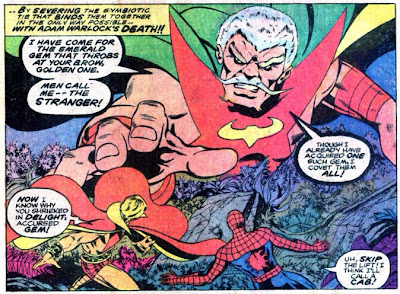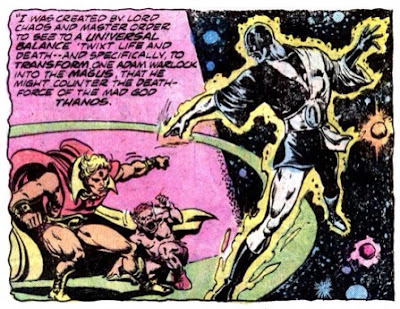Warlock's appearances in the second half of the 1970s are fewer and - once more - take place in a range of other, more popular, titles. His 70s adventures end in the Starlin-plotted and drawn Avengers Annual 7 and Marvel Two-in-One Annual 2. Warlock gets a bittersweet ending, surrounded by friends - but does, finally, deal with Thanos. It's a shame that Warlock ended at this point. Although a "cosmic" character, he is perfectly at home with The Avengers and it's interesting to consider how much more successful he would have been if involved in the regular Marvel Universe earlier rather than artificially separating him through devices like Counter-Earth or sending him to the other side of the galaxy (and making him physically the size of the solar system).
Much obliged, Goldy: Marvel Team-Up #55
Six months after the termination of the
Warlock title, the great John Byrne gets a chance to draw Adam Warlock in a bizarre team-up with Spider-man on the Moon! Byrne draws Warlock superbly, giving him a tougher, heroic demeanour - but Bill Mantlo's plot is pretty thin. Following an issue involving the Hulk and a faun-like character called Woodgod, Spider-man is blasted in a rocket into space and finds himself quickly running out of air. Luckily enough, Warlock is passing by - though careful readers would have remembered that he'd abandoned Earth for the depths of space due to his increased size and might be scratching their heads about why he's back in this part of the universe (see
Warlock #14 for details). It's ok, though: Warlock has found a remedy for this cosmic affliction: "It seems that warping through space has gradually reversed the process. I have grown smaller." Luckily, Warlock had done enough "warping" to return to his original proportions. (Although this is a dumb solution - it's really no dumber than making Warlock the size of a solar system anyhow.) Warlock detects air in the "Blue Area" on the Moon and sends the rocket there.
 |
| The Stranger covets Warlock's soul gem! |
Unfortunately, in the "Blue Area" is The Stranger, a gigantic alien who had been knocking around the Marvel Universe since
Uncanny X-men #16. The Stranger already has one of the Infinity Gems (though we don't know them as that yet) and desires Warlock's to enhance his power. There's also another character on the Moon called The Gardener who is... well... a gardener. Warlock gets beaten unconscious and strapped to "stasis arcs" so that The Stranger can take the soul gem. Eventually - after a great deal of Spider-man spraying webbing at The Stranger, Warlock and The Gardener team up to drive The Stranger off. The battle, however, corrupts The Gardener's gem and he realises that it has become a weapon. The issue ends with Warlock explaining to Spider-man that he is on his way to Counter-Earth... but, as Warlock's next appearance suggests, whatever was supposed to happen on Counter-Earth is forgotten as the threat of Thanos becomes the focus for Warlock's final story.
...in this oneness there can only be love: The Avengers Annual 07
You can tell it's going to be a dark story when the opening pages have Warlock finding Gamora dying and using his soul gem to put her out of her misery. She had been attacked by the Destroyer and survived in order to make a failed assassination attempt on Thanos. The opening pages are shadowy and sombre and creates a tone that continues throughout this issue and its conclusion in
Marvel Two-in-One Annual 2. Gamora's death sets Warlock off on a course of revenge - recruiting the current team of Avengers on the way (there's a neat scene where Thor recognises Warlock as Him). Using his soul gem on Gamora enables Warlock to recount the history of Thanos to the Avengers and we get an account of where all six Infinity Gems are located. Thanos' wicked plan is to transfer all the powers of the different gems into a single large synthetic gem and plans to blow every star out of existence as a love offering for Death. The Avengers take to space to battle Thanos' army and, during the battle, Warlock and Captain Marvel find what's left of Pip - Thanos had destroyed the troll's mind. After sucking Pip's soul into his gem, Warlock fights Thanos only to be mortally wounded. (Warlock is a bit pathetic, really. For all his talk of god-like powers and the fact he has the soul gem, Thanos flattens him instantaneously.) The Avengers destroy the synthetic gem and Thanos teleports himself away.
 |
| Captain Marvel sees time-travelling Warlock kill himself. |
Watched by Captain Marvel, we observe the scene from Warlock #11 where the younger Warlock who had been battling Magus kills the older Warlock by sucking his soul into the gem and then returning to his own time.
 |
| Warloc... happy at last. |
Rather than that being the end of things, Warlock finds himself inside the soul gem in some sort of heavenly afterlife. He is greeted by Gamora and Pip who also still exist as well as all the beings Warlock has killed with the soul gem (we even see Kray-tor, the egg-like six-armed judge of the Universal Church waving merrily). Now, they all share a collective existence of peace and harmony. For the first time Warlock looks happy and Warlock concludes that "They're... we're all here together... truly together, for our hearts are open books and this atmosphere breeds understanding and mutes the ego. Here we are all one and in this oneness there can only be... love." The final panel is 100% bittersweet Hollywood ending: Warlock embracing Pip and Gamora as the walk into the distance with all his former enemies greeting him. The End. Well... no, Warlock isn't finished yet. He makes one more appearance before he's put to rest.
 |
| Inside the heavenly interior of the soul gem. |
Destined to spend infinity trapped within the petrified form of his own corruption: Marvel Two-In-One Annual 02
So, Warlock's happily living out his afterlife inside the vampiric soul gem that's on the forehead of his younger self. I have trouble actually understanding how this works. What happens to the soul gem of the dead Warlock? Is the dead Warlock inside the living (younger) Warlock's soul gem - and, if so, how come Warlock isn't aware of this in the same way that he's aware of all the other people he kills? It's certainly a conundrum that doesn't satisfactorily make sense (maybe in later issues when Warlock gets resurrected it'll become clear). In Marvel Two-in-One Annual 2, The Avengers have been captured by Thanos and Moondragon (the bald C-list Avenger) sends out a "mental call" to Spider-man. Thanos takes the soul gem to continue with his plan to destroy the sun. Spidey recruits The Thing to take him into space to Thanos' ark. Meanwhile some cosmic entities (fates? - one called "Lord Chaos") debate the situation and explain that Spider-man and The Thing's role was to release Warlock from the soul gem. We get a view of Warlock's idyllic post-death existence: a rural scene where his former enemies sit on rock or wander about happily. The Thing attempts to fight Thanos and Spidey - quite out of character - runs away in blind panic. He does, however, return to release The Avengers and there's a tremedous battle that Thanos wins once more. Warlock is called back to reality by the cosmic entities and released by Spidey.
 |
| Warlock gets mean! |
Warlock appears as a fiery being and describes himself as the "Ultimate Avenger" and attacks Thanos, transforming the mad Titan into solid granite. As a coda to the story, the Avengers bury Warlock "amidst the heavens".
 |
| Warlock, the Ultimate Avenger. |
Captain Marvel, despite only having recently met Warlock, provides the eulogy: pointing out that Warlock felt out of place on Earth and preferred wandering the universe, that he was naive, haunted by cynicism and "Finally, he found light, life and truth to be his only values, and so became misunderstood and alone." How Captain Marvel knew all this, I don't know. (It's interesting that he also mentions that everyone dies and hopes he will die as honourably as Warlock - foreshadowing his own illness and death a few years later.) Equally, Spidey - who also only met Warlock once - is quite upset by the death and it takes Ben Grimm to comfort him with an ironic comment about Warlock having "a new and better beginning somewhere else". We get one final glimpse of Warlock: telling Gamora that "it looks like we'll just have to get used to living here in paradise without any strife, problemsor pain." It is the Hollywood ending at last. His murderer, Thanos, is set to spend infinity "trapped within the petrified form of his own corruption".
 |
| Warlock's headstone. |
Glowing man was smart: The Incredible Hulk Annual 06
Warlock's appearances in subsequent comics of the 1970s are flashbacks that utilise characters introduced in the run. In the
Hulk Annual 6, Doctor Strange is forced to work for the Beehive (in a manner very much like Alicia Masters in
FF #66-67) in order to work on their second version of Him. Strange is brought in for his surgeon's skills and he works on the brain of the new Him inside its cocoon. While the Hulk fights his way across the world to the Beehive's base to rescue Strange, an artificial human called Paragon emerges from the cocoon and more or less repeats what Him did ten years earlier: refusing to obey the Beehive scientists and fighting anyone he encounters. The Beehive, who seemed to have been destroyed by Him as he left Earth at the end of FF #67, were actually moved to another dimension rather than killed (Paragon says "banished").
 |
| The Paragon (aka Him 2... though he becomes Her!) |
I do not fear death, Inbetweener: Doctor Strange #27
In this February 1978 issue of
Doctor Strange, Roger Stern brings The Inbetweener, the entity that Magus summoned to send Warlock insane, into the regular Marvel Universe. In an amazing-looking issue pencilled by Tom Sutton and inked by Ernie Chan, Inbetweener presents himself to Strange in order to explain his role of maintaining balance in the universe. There's a flashback where he recounts his relationship with Warlock and explains that he has been searching for other "projects" to bring balance to things. Typically, it's a trippy issue which mostly involves a prolonged battle with Stygyro, prince of sorcerers. Warlock only actually appears in a couple of panels:
 |
| The Inbetweener recalls his role in creating Magus |
 |
| Life ending for Warlock |
The wreckage is still smokin', Spidey: The Spectacular Spider-Man #15
Warlock's final posthumous appearance in the 1970s is in a Bill Mantlo scripted issue of
Spectacular Spider-man where Man-Beast has escaped Counter-Earth and arrived on (real) Earth to lead a religious sect (Mantlo had also written the Spider-man/Warlock team-up). Spidey defeats Man-Beast's "hate amplifiers" to save the day. Warlock is remembered in a flashback sequence where Man-Beast relates his origins. Warlock is described as "the more-than-man". Man-Beast simply re-evolved from a dog after Warlock had left Counter Earth for deep space. Probably, for the average Marvel reader, this final presentation of Warlock - as some sort of weird golden superhero who was the enemy of a rubbish dog-villain - is the one that endured.
 |
| Man-Beast survived Warlock's de-evolution |














































